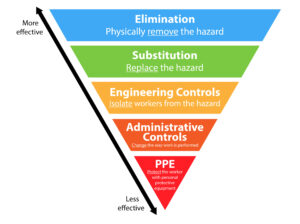NIOSH: Implementation of engineering controls may help reduce worker exposure to drill site hazards, long-term risks
By Stephen Whitfield, Associate Editor
Life on the rig can present a number of challenges, and without proper monitoring, these challenges could lead to long-term health hazards for workers. These hazards might be difficult to identify at times, but there are steps companies can take to isolate people from the hazards. Some of those steps are rooted in the design of the rig.
Speaking at the IADC HSE&T Conference in Houston on 18 February, Barbara Alexander, Senior Service Fellow at the US National Institute for Occupational Safety and Health (NIOSH), explained some of the engineering controls that could be useful in this area.
Ms Alexander identified four potential types of health hazards and the ways in which exposures can happen:
- Chemical hazards through inhalation, ingestion, injection or dermal exposure;
- Physical hazards through radiation exposure, noise, temperature, vibration, pressure, or slips and falls;
- Ergonomic hazards through lifting and repetitive motions; and
- Biological hazards through exposure to bacteria and viruses.

As part of its Prevention Through Design initiative, NIOSH established a hierarchy of controls that establishes a means of determining how to implement effective control solutions to handle potential hazards. This hierarchy is often represented graphically as an inverted pyramid (Figure 2), and the idea behind it is that the control methods at the top of the pyramid (elimination, substitution, engineering controls) are more effective than those at the bottom (administrative controls and personal protective equipment, or PPE).
While the hierarchy was not specifically developed for drillers, Ms Alexander explained how each step could be applied to a drilling context.
Elimination, or physically removing a hazard, could involve a company eliminating the process of workers physically adding additive powders to drilling fluid. Substitution could mean replacing a company’s old powder with a silica-free powder. Engineering controls could mean installing local exhaust ventilation for workers adding the powder to the fluid. Administrative controls could include the company limiting worker hours, and PPE could mean requiring those workers to wear respirators when handling powders.
Even though the hierarchy is listed in order of effectiveness, Ms Alexander said each step can be valuable in reducing exposures. PPE, for instance, is listed as the least effective control method of the five, but she said it is often the first step companies go to when a hazard presents itself.
“When you see somebody’s being exposed to something, what do we do? Put that person in a respirator, or have them wear hearing protection. There are some slightly more preferred ways to control those exposures, but that’s not meant to minimize the importance of PPE. I would say that we’re all being saved by our earplugs and our respirators, but it’s just not as obvious because those kinds of damage come a little bit at a time,” Ms Alexander said.
The drill floor is obviously one of the main places on a rig where workers can encounter hazards. There, iron roughnecks have become an important engineering controls for hazards, by taking away some of the manual labor that humans have done in the past. However, despite the growing presence of automation on the drill floor, workers still have to perform various high-exertion tasks, she added.

In her presentation, Ms Alexander spoke of an observation of rig workers being exposed to drilling fluid while pulling the bottomhole assembly. While fluid-resistant and flame-retardant coveralls were available at no cost to the workers, she said that, according to management, they typically did not use them.
“The mud bucket was called for when it was being disconnected. At one moment, one bucket was being taken away a little bit too early, and I observed a dermal exposure and an ingestion exposure. The poor worker was spitting out drilling mud after the pipe let loose. Wearing fluid-resistant coveralls would not have prevented the ingestion exposure, but it would have kept a lot of that drilling mud off the worker’s skin,” Ms Alexander said.
Hopper houses also present chemical and ergonomic hazards. Workers often have to handle heavy bags of additives when transferring them to the hopper, and the repetitive bending and lifting of those bags from pallets can affect a worker’s physical well being. Ms Alexander suggested the use of lift tables to reduce worker bending, or potentially vacuum lift devices that could remove the burden of handling the bags from the worker. However, she acknowledged that vacuum lifts require a higher overhead clearance that may not be available.
Ventilation can often be an issue with hopper houses, as fans may not do much to prevent workers from inhaling dust from the additive powders. Ms Alexander referenced a site visit where NIOSH measured airborne exposure to crystalline silica in a hopper house as higher than the program’s recommended limit of .05 kg/cu m.
“We’re all being saved by our earplugs and our respirators, but it’s just not as obvious.”
– Barbara Alexander, NIOSH
According to the US Occupational Safety and Health Administration, workers exposed to respirable crystalline silica are at increased risk of developing serious silica-related diseases, which include lung cancer and chronic obstructive pulmonary disease.
Even in situations where a derrick hand is wearing a respirator, Ms Alexander said there is still inhalation risk.
“I have to ask myself, where is that respirator when he’s not wearing it? Is it laying somewhere where dust can accumulate inside of it? These are things to consider,” she said.
Ms Alexander presented an alternative design for hopper houses in which additives would be added to the hopper behind a curtain of plastic strips.
mpty bags could be flattened inside the exposure and removed in a waste bag collection unit, with exhaust being funneled through a pipe. Such a setup, Ms Alexander said, would do a better job at controlling the dust in the air as opposed to a conventional hopper house design. DC





